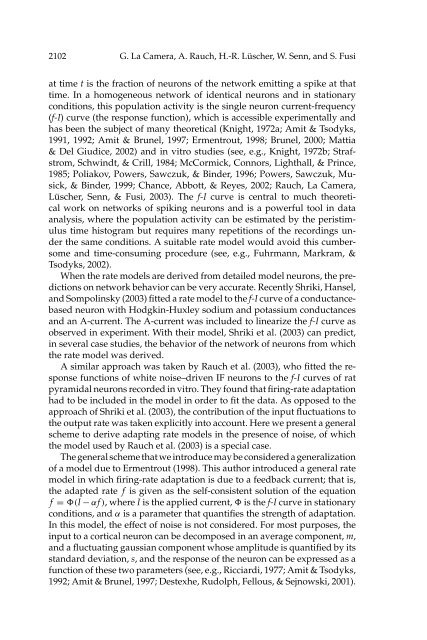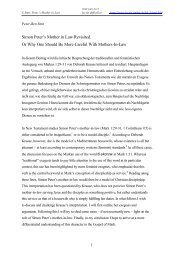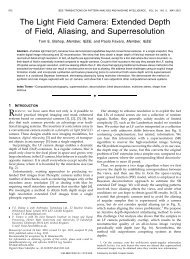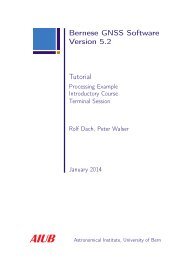Minimal Models of Adapted Neuronal Response to In Vivo–Like ...
Minimal Models of Adapted Neuronal Response to In Vivo–Like ...
Minimal Models of Adapted Neuronal Response to In Vivo–Like ...
Create successful ePaper yourself
Turn your PDF publications into a flip-book with our unique Google optimized e-Paper software.
2102 G. La Camera, A. Rauch, H.-R. Lüscher, W. Senn, and S. Fusi<br />
at time t is the fraction <strong>of</strong> neurons <strong>of</strong> the network emitting a spike at that<br />
time. <strong>In</strong> a homogeneous network <strong>of</strong> identical neurons and in stationary<br />
conditions, this population activity is the single neuron current-frequency<br />
(f-I) curve (the response function), which is accessible experimentally and<br />
has been the subject <strong>of</strong> many theoretical (Knight, 1972a; Amit & Tsodyks,<br />
1991, 1992; Amit & Brunel, 1997; Ermentrout, 1998; Brunel, 2000; Mattia<br />
& Del Giudice, 2002) and in vitro studies (see, e.g., Knight, 1972b; Strafstrom,<br />
Schwindt, & Crill, 1984; McCormick, Connors, Lighthall, & Prince,<br />
1985; Poliakov, Powers, Sawczuk, & Binder, 1996; Powers, Sawczuk, Musick,<br />
& Binder, 1999; Chance, Abbott, & Reyes, 2002; Rauch, La Camera,<br />
Lüscher, Senn, & Fusi, 2003). The f-I curve is central <strong>to</strong> much theoretical<br />
work on networks <strong>of</strong> spiking neurons and is a powerful <strong>to</strong>ol in data<br />
analysis, where the population activity can be estimated by the peristimulus<br />
time his<strong>to</strong>gram but requires many repetitions <strong>of</strong> the recordings under<br />
the same conditions. A suitable rate model would avoid this cumbersome<br />
and time-consuming procedure (see, e.g., Fuhrmann, Markram, &<br />
Tsodyks, 2002).<br />
When the rate models are derived from detailed model neurons, the predictions<br />
on network behavior can be very accurate. Recently Shriki, Hansel,<br />
and Sompolinsky (2003) fitted a rate model <strong>to</strong> the f-I curve <strong>of</strong> a conductancebased<br />
neuron with Hodgkin-Huxley sodium and potassium conductances<br />
and an A-current. The A-current was included <strong>to</strong> linearize the f-I curve as<br />
observed in experiment. With their model, Shriki et al. (2003) can predict,<br />
in several case studies, the behavior <strong>of</strong> the network <strong>of</strong> neurons from which<br />
the rate model was derived.<br />
A similar approach was taken by Rauch et al. (2003), who fitted the response<br />
functions <strong>of</strong> white noise–driven IF neurons <strong>to</strong> the f-I curves <strong>of</strong> rat<br />
pyramidal neurons recorded in vitro. They found that firing-rate adaptation<br />
had <strong>to</strong> be included in the model in order <strong>to</strong> fit the data. As opposed <strong>to</strong> the<br />
approach <strong>of</strong> Shriki et al. (2003), the contribution <strong>of</strong> the input fluctuations <strong>to</strong><br />
the output rate was taken explicitly in<strong>to</strong> account. Here we present a general<br />
scheme <strong>to</strong> derive adapting rate models in the presence <strong>of</strong> noise, <strong>of</strong> which<br />
the model used by Rauch et al. (2003) is a special case.<br />
The general scheme that we introduce may be considered a generalization<br />
<strong>of</strong> a model due <strong>to</strong> Ermentrout (1998). This author introduced a general rate<br />
model in which firing-rate adaptation is due <strong>to</strong> a feedback current; that is,<br />
the adapted rate f is given as the self-consistent solution <strong>of</strong> the equation<br />
f = (I − αf ), where I is the applied current, is the f-I curve in stationary<br />
conditions, and α is a parameter that quantifies the strength <strong>of</strong> adaptation.<br />
<strong>In</strong> this model, the effect <strong>of</strong> noise is not considered. For most purposes, the<br />
input <strong>to</strong> a cortical neuron can be decomposed in an average component, m,<br />
and a fluctuating gaussian component whose amplitude is quantified by its<br />
standard deviation, s, and the response <strong>of</strong> the neuron can be expressed as a<br />
function <strong>of</strong> these two parameters (see, e.g., Ricciardi, 1977; Amit & Tsodyks,<br />
1992; Amit & Brunel, 1997; Destexhe, Rudolph, Fellous, & Sejnowski, 2001).
















